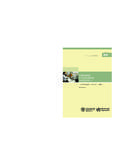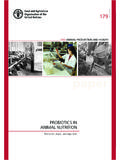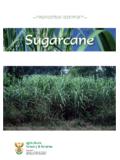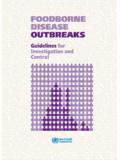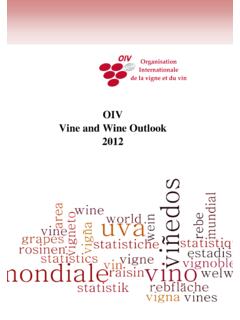Transcription of Grain Reserves and Food Security in MENA Countries
1 Grain Reserves and food Security in MENA Countries BRIAN WRIGHT. University of California, Berkeley and CARLO CAFIERO. University of Naples Federico II, Italy Abstract Aggregate stocks of major grains declined to minimal feasible levels in 2007/08, due to high global income growth and biofuels mandates. Given minimal stocks, prices were very sensitive to shocks such as the Australian drought and biofuels demand boosts due to the oil price spike. The effects of these shocks were magnified by a sequence of trade restrictions by key exporters to protect vulnerable consumers, beginning in the thin global rice market in the fall of 2007, which turned market anxiety into panic. Recognizing the unreliability of imports, vulnerable Countries , including those in the Middle East and North Africa, (MENA), are now considering investing in strategic Reserves , pursuit of self sufficiency, and acquisition of foreign land to ensure supplies for Grain for domestic consumption.
2 The associated expense and negative incentive effects of national Reserves may be acceptable if they have quantitative targets related to the consumption needs of the most vulnerable, with distribution to the latter only in severe emergencies. In many MENA Countries , heavy subsidies on Grain consumption of both rich and poor reduce the stabilizing response of consumption to price, and increase the size of Reserves needed to ensure any given level of food Security . In most MENA Countries , accumulation of stocks is a more efficient strategy than pursuit of self sufficiency, because these Countries have no comparative advantage in expanded agriculture, due fundamentally to lack of water supplies. Acquisition of foreign lands leaves food supplies exposed to sovereign risk and other interruptions to the supply chain beyond the importer's control.
3 On the other hand collaboration among MENA Countries could allow them to smooth a sizeable part of the risks posed by fluctuations in their own harvests. ii . 1. Introduction: The food price crisis of 2007/08 and the emergence of concerns over its impact on food Security After experiencing the turmoil in the Grain markets starting in 2007, the prospect of continuing high Grain market volatility is particularly threatening to Countries of the Middle East and North Africa (MENA).1 Their special vulnerability comes from their high levels of cereal consumption and heavy dependence on imports (World Bank, 2009). As much as 35 percent of calorie consumption in the region comes from wheat alone, and the region is collectively a net importer of million metric tons of cereal, making it the largest net importing region in the world.
4 Import dependence is projected to increase from 56 percent in 2000 to 63 percent in 2030, leaving the region even more vulnerable to high and volatile international market prices. In the throes of the market chaos of 2007/08, pressure from their urban consumers forced many importers, including some MENA Countries like Morocco and Saudi Arabia to remove tariffs or subsidize imports of grains (Hater, 2008). These importer policies stabilized local markets to some extent, but they penalized the domestic farmers and traders whose supplies to the market prevented more serious shortages. Furthermore, their collective effect was to exacerbate international price volatility. On the other side of the market, exporters responded to similar pressure from their politically powerful consumers by limiting or banning exports, which penalized their producers and further destabilized the international market on which importers relied for food Security .
5 (See Wright forthcoming.). As Grain prices have receded significantly from their 2008 highs, the policy focus switched from short-term tactics for crisis management to strategies to manage the effects of market fluctuations on consumers at acceptable cost. Suggestions to increase global Grain Reserves have figured prominently in international discussions. Proposals have been made for international Reserves combined with what advocates describe as virtual Reserves controlled via commodity futures and options trading. Special regional emergency Reserves have been proposed for 1. Countries generally included in MENA are Algeria, Bahrain, Djibouti, Egypt, Iran, Iraq, Israel, Jordan, Kuwait, Lebanon, Libya, Morocco, Oman, Qatar, Saudi Arabia, Ethiopia, Sudan, Syria, Tunisia, United Arab Emirates, and Yemen. The total population is similar in size to that of the European Union.
6 1 . Countries that view possible lack of access to the global trade as a serious issue. Some observers have also recommended regulation of commodity futures trading by noncommercial investors, while Ethiopia is supporting establishment of a new futures exchange as part of their Grain market policy (Jopson and Blas, 2008). Many have pressed for reductions in subsidies or mandates for biofuel production, on the grounds that such policies threaten the stability of food markets. Several MENA Countries , along with China and India, have taken steps to secure land in Africa and elsewhere to produce grains to augment their domestic supplies (Economist 2009). After price volatility subsided, Russia, a recently emerged major exporter, formulated a proposal for a wheat export cartel with the other large Black Sea exporters, Ukraine and Kazakhstan, and this idea was discussed at the World Grain Forum in St.
7 Petersburg in 2009. It was clear that problems with market access and exposure to exporter supply manipulation might persist for some time. Only a year later, in the summer of 2010, Russia announced a Grain export ban in response to unprecedented hot weather and fires in its wheat producing regions, and there are rumors of bans by the Ukraine and others. Wheat prices have recently jumped, and food Security is now on the policy agenda as both a pressing short run issue and a longer run policy challenge for nations in the MENA region. In this context, the main objective of this paper is to provide government officials, civil society organizations and officials of international organization involved in food Security with an overview of the potential roles and problems associated with using physical storage and related policies as means of enhancing food Security .
8 The paper discusses how MENA Countries can use storage to address their food Security related needs and challenges. It shows how storage, if properly managed, can effectively integrate international trade and other domestic policies in achieving an acceptable level of food Security . In particular, it concludes that storage will inevitably be used to reduce the risks of food shortages. In doing so, it will be important to avoid the unsustainable costs associated with complete self-sufficiency in food production by Countries with a limited agricultural production potential due to water scarcity and other resource related constraints. We aim to put in proper perspective the many options that are currently being discussed in various forums in the MENA region by policy makers who rightly consider food Security for their citizens to be an important national goal.
9 The paper is designed to assist those Countries 2 . who aim to achieve greater food Security by illuminating the costs as well as the benefits of alternative routes that might be taken in pursuit of that goal. 2. Strategy and policy options for enhanced food Security in the Arab region, in face of recent food price volatility Aggregate food price behavior in the past two decades. Figure 1 shows the United Nations FAO food price index, a measure of behavior of aggregate food prices in the past few decades. Essentially flat in the early 1990s, it rose substantially around 1996, then declined to a new lower base 1998 until 2003. The index then began to rise, and by 2005 had risen almost 20% above the 1998 2000 average. In 2006 price increases started to accelerate, and by October were on a sharp uptrend that continued until summer 2008, when the index exceeded twice its 2005 level, but since then has fluctuated considerably.
10 It is now above its average level in 2007, though still substantially below the 2008 peak. Figure 1. UN FAO food price index (1990 2009) (2002/04=100). (Source: FAO). 3 . This aggregate food price index understates the fluctuations in the prices of the major food grains that have attracted the bulk of the attention in discussions of food prices. Figure 2, which offers a longer view, shows that the real price of wheat in the US followed a downward trend for decades, reflecting the fact that yield growth has on average exceeded demand growth, contrary to Malthusian predictions of the 1960's. The price generally moves within a narrow band along the downward trend. At irregular intervals, large price jumps occur, generally succeeded immediately by steep falls back towards the trend level. Price troughs well below trend are not evident; price behavior is asymmetric.










